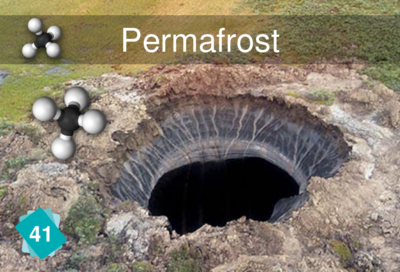En-en adult card 41 permafrost: Difference between revisions
m (Minor corrections) |
(Card update) |
||
| (6 intermediate revisions by 2 users not shown) | |||
| Line 1: | Line 1: | ||
== Card #41: Permafrost == | |||
| | <center> | ||
[[File:En-en_adult_card_41_front.png|400px]] | |||
Permafrost is permanently frozen ground. It is starting to melt, releasing into the atmosphere previously locked-in methane and CO<sub>2</sub> from decomposed biomass. This creates a negative feedback loop, just like forest fires and albedo changes due to melting sea ice. | |||
</center> | |||
==Explanation== | ==Explanation== | ||
Permafrost is soil that is permanently frozen for at least two consecutive years<ref>[https://www.ipcc.ch/site/assets/uploads/2018/03/WG1AR5_SummaryVolume_FINAL_FRENCH.pdf#page=212 Glossary, Report 5, Working Group 1 (French)]</ref>. | Permafrost is soil that is permanently frozen for at least two consecutive years<ref>[https://www.ipcc.ch/site/assets/uploads/2018/03/WG1AR5_SummaryVolume_FINAL_FRENCH.pdf#page=212 Glossary, Report 5, Working Group 1 (French)]</ref>. | ||
The two last cards to be added to the | The two last cards to be added to the Fresk after card 40 are potentially violent [[wikipedia:Climate_change_feedback|feedback]] loops or "climate bombs" which, if triggered, would cause us to lose control over the climate for good. | ||
Thermokarst are veritable bioreactors at the heart of the process of releasing frozen carbon: when the permafrost thaws, pieces of soil detach and fall into the water, bringing nutrients and carbon to the bacteria and plankton present in the sea, which degrade them into CO<sub>2</sub> (in the water layers near the surface) and methane (CH<sub>4</sub> -- in the oxygen-deprived | Thermokarst are veritable bioreactors at the heart of the process of releasing frozen carbon: when the permafrost thaws, pieces of soil detach and fall into the water, bringing nutrients and carbon to the bacteria and plankton present in the sea, which degrade them into CO<sub>2</sub> (in the water layers near the surface) and methane (CH<sub>4</sub> -- in the oxygen-deprived depths)<ref>[https://lejournal.cnrs.fr/articles/pergelisol-le-piege-climatique CNRS The newspaper Permafrost, the climate trap (French)]</ref>. | ||
==Correction == | ==Correction == | ||
===Causes=== | ===Causes=== | ||
*[[En- | *[[En-en adult card 21 temperature rise|Rising Air Temperatures]] | ||
===Consequences=== | ===Consequences=== | ||
*[[En-en_adult_card_9_other_ghgs|Other GHGs]] | *[[En-en_adult_card_9_other_ghgs|Other GHGs]] | ||
==Other possible links== | ==Other possible links== | ||
===Other causes=== | |||
*[[En-en adult card 14 energy budget|Energy budget]] If we take the idea of energy conservation all the way, we can link the thawing permafrost back to the energy budget. | |||
===Other | ===Other consequences=== | ||
[[En-en adult card | * [[En-en adult card 13 additional greenhouse effect|Additional greenhouse effect]] The permafrost card can be linked either to Other GHGs or to Additional Greenhouse Effect. The Other GHGs card is about GHGs emitted by human activities, while the methane in permafrost is not of human origin. | ||
*[[En-en adult card 28 vectors of disease|Vectors of disease]] Permafrost contains billions of buried bacteria and viruses. If it melts, diseases might contaminate humans and animals. In 2016, there was an [https://www.bbc.com/news/world-europe-36951542 outbreak of anthrax] caused by a melted reindeer carcass. | |||
==To go further== | ==To go further== | ||
Latest revision as of 17:45, 30 October 2021
Card #41: Permafrost
Permafrost is permanently frozen ground. It is starting to melt, releasing into the atmosphere previously locked-in methane and CO2 from decomposed biomass. This creates a negative feedback loop, just like forest fires and albedo changes due to melting sea ice.
Explanation
Permafrost is soil that is permanently frozen for at least two consecutive years[1].
The two last cards to be added to the Fresk after card 40 are potentially violent feedback loops or "climate bombs" which, if triggered, would cause us to lose control over the climate for good.
Thermokarst are veritable bioreactors at the heart of the process of releasing frozen carbon: when the permafrost thaws, pieces of soil detach and fall into the water, bringing nutrients and carbon to the bacteria and plankton present in the sea, which degrade them into CO2 (in the water layers near the surface) and methane (CH4 -- in the oxygen-deprived depths)[2].
Correction
Causes
Consequences
Other possible links
Other causes
- Energy budget If we take the idea of energy conservation all the way, we can link the thawing permafrost back to the energy budget.
Other consequences
- Additional greenhouse effect The permafrost card can be linked either to Other GHGs or to Additional Greenhouse Effect. The Other GHGs card is about GHGs emitted by human activities, while the methane in permafrost is not of human origin.
- Vectors of disease Permafrost contains billions of buried bacteria and viruses. If it melts, diseases might contaminate humans and animals. In 2016, there was an outbreak of anthrax caused by a melted reindeer carcass.
To go further
For online murals, you can show this video from the University of Alaska Fairbanks showing the flammable methane stored in the permafrost.
Climate Action Network France: Thawing permafrost carbon will increase global warming, 2018 (French)
RT France documentary: The mystery of permafrost (French)
